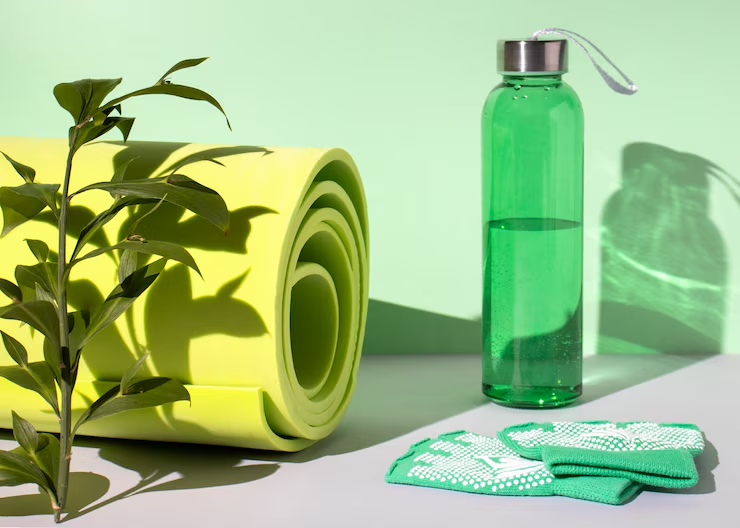As more people embrace sustainability in their daily lives, the demand for eco-friendly yoga mats has risen significantly. Traditional yoga mats are often made from PVC (polyvinyl chloride), a material that is not only harmful to the environment but can also release toxic chemicals into the air. In contrast, eco-friendly yoga mats are made from natural, biodegradable, and non-toxic materials that are safer for both you and the planet. If you’re looking to make your yoga practice more sustainable, switching to an eco-friendly yoga mat is a great first step.
Why Choose an Eco-Friendly Yoga Mat?
Eco-friendly yoga mats offer numerous benefits for both the practitioner and the environment. Here are a few reasons why they should be your go-to choice for yoga sessions:
- Non-Toxic Materials: Eco-friendly mats are made from natural materials like rubber, jute, cork, or TPE (Thermoplastic Elastomer), which are free from harmful chemicals such as PVC, phthalates, or BPA.
- Sustainable and Biodegradable: These mats are often made from renewable resources, and many of them are biodegradable or recyclable, which helps reduce waste in landfills.
- Durability and Comfort: Eco-friendly yoga mats are designed to be just as durable, comfortable, and supportive as traditional mats, providing a firm, slip-resistant surface for your yoga practice.
- Environmentally Responsible: By choosing an eco-friendly yoga mat, you’re helping to reduce your environmental footprint and supporting companies that prioritize sustainability.
Types of Eco-Friendly Yoga Mats
1. Natural Rubber Yoga Mats
One of the most popular materials for eco-friendly yoga mats is natural rubber. Made from latex extracted from rubber trees, these mats are durable, slip-resistant, and provide excellent cushioning. Rubber mats are biodegradable and free from harmful chemicals, making them a great option for those looking for a sustainable and safe mat for their practice. They offer superior grip, making them ideal for all types of yoga.
2. Cork Yoga Mats
Cork yoga mats are made from a combination of natural rubber and cork, which is a renewable material harvested from the bark of cork oak trees. Cork mats offer a unique combination of sustainability, comfort, and style. They are non-toxic, biodegradable, and naturally anti-bacterial. Cork also provides a smooth, non-slip surface that is perfect for both beginners and advanced practitioners.
3. Jute Yoga Mats
Jute is a natural fiber that is biodegradable and highly sustainable. Jute yoga mats are made by weaving jute fibers together to create a textured surface that provides excellent grip and cushioning during your practice. These mats are ideal for those who prefer a more textured surface and are looking for a yoga mat that is both eco-friendly and stylish.
4. TPE Yoga Mats
Thermoplastic Elastomer (TPE) is a non-toxic, lightweight, and durable material that is often used for eco-friendly yoga mats. TPE mats are free from PVC, phthalates, and other harmful chemicals, making them a safer choice for both you and the environment. These mats are also 100% recyclable, which makes them an excellent option for reducing waste. TPE mats provide a smooth, comfortable surface for yoga practice and are available in a variety of colors and thicknesses.
5. Hemp Yoga Mats
Hemp is another natural and sustainable material used in eco-friendly yoga mats. Known for its strength and durability, hemp provides a firm and supportive surface for your practice. Hemp mats are also biodegradable, making them an excellent choice for environmentally conscious yogis. These mats are typically paired with a natural rubber base to provide additional grip and comfort during yoga poses.
Benefits of Using an Eco-Friendly Yoga Mat
1. Healthier for You and the Planet
Traditional yoga mats can contain harmful chemicals like PVC, which can off-gas toxic fumes, especially when exposed to heat or sunlight. Eco-friendly yoga mats, on the other hand, are made from natural and non-toxic materials that are safer for your health and the environment. They are free from harmful substances like PVC, phthalates, and BPA, ensuring that you can practice yoga without the risk of inhaling or coming into contact with toxic chemicals.
2. Durable and Long-Lasting
Eco-friendly yoga mats are designed to be just as durable, if not more so, than traditional mats. Made from high-quality materials like natural rubber or TPE, these mats offer excellent cushioning, grip, and support. They are built to withstand the rigors of daily use and are resistant to wear and tear. Investing in an eco-friendly mat means you won’t need to replace it as often, making it a cost-effective choice in the long run.
3. Comfortable for Your Practice
One of the most important features of a yoga mat is its comfort level. Eco-friendly yoga mats provide excellent cushioning to protect your joints while also offering a firm grip to support your poses. Whether you’re practicing hot yoga, vinyasa, or restorative yoga, these mats will give you the stability and comfort you need to perform your practice with ease.
4. Easy to Clean and Maintain
Eco-friendly yoga mats are easy to clean and maintain, ensuring that they stay fresh and hygienic for long periods of use. Most natural rubber, cork, and TPE mats can be wiped down with a damp cloth after each use, and some can even be washed with mild soap and water. Regular cleaning helps remove sweat and bacteria, keeping your mat in top condition.
How to Care for Your Eco-Friendly Yoga Mat
To ensure the longevity of your eco-friendly yoga mat, here are some tips on how to care for it:
- Clean Regularly: After each use, wipe down your yoga mat with a damp cloth to remove sweat and dirt. For deeper cleaning, use mild soap and water.
- Avoid Excessive Heat: Keep your mat away from direct sunlight or heat sources, as this can cause it to degrade over time.
- Store Properly: Roll up your mat after each practice and store it in a cool, dry place. Avoid folding your mat, as this can cause creases and affect its durability.
- Use a Mat Bag: Consider using a yoga mat bag to protect your mat when you’re not using it, especially if you’re traveling or storing it for extended periods.
Final Thoughts
Choosing an eco-friendly yoga mat is a simple yet impactful way to make your yoga practice more sustainable. These mats are made from natural and non-toxic materials that provide the durability, comfort, and grip needed for a great yoga session while reducing your environmental footprint. Whether you’re a beginner or a seasoned yogi, investing in an eco-friendly yoga mat is a step toward living a more conscious, eco-friendly lifestyle.


![WishKraft CORK Yoga Mat with Storage Bag & Strap [5 MM Thick] Eco-Friendly, Non-Slip, & Sweat Resistant | Cushioning, Support & Stability for Exercise, Fitness, Meditation & Pilates](https://m.media-amazon.com/images/I/51eov1midhL._SL500_.jpg)







